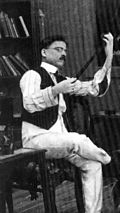Wikipedia:Main Page history/2019 May 3
From today's featured articleScientific Detective Monthly was a pulp magazine published by Hugo Gernsback, first appearing in January 1930. It was intended to focus on detective and mystery stories with a scientific element, but there were also one or two science fiction stories in every issue. The title was changed to Amazing Detective Tales with the June 1930 issue, perhaps to avoid the word "scientific", which may have given readers the impression of "a sort of scientific periodical", in Gernsback's words, rather than a magazine intended to entertain. At the same time, the editor—Hector Grey—was replaced by David Lasser, who was already editing Gernsback's other science fiction magazines. The title change apparently did not make the magazine a success, and Gernsback closed it down in October after releasing 10 issues. He sold the title to publisher Wallace Bamber, who produced at least five more issues in 1931 under the title Amazing Detective Stories. (Full article...)
Recently featured:
Did you know...
|
In the news
On this dayMay 3: World Press Freedom Day; Constitution Day in Japan (1947) and Poland (1791)
Élisabeth of France (b. 1764) · Jacob Riis (b. 1849) · John O'Connor (d. 2000) |
From today's featured list
The Dadasaheb Phalke Award is India's highest award in cinema. It is presented annually at the National Film Awards ceremony by the Directorate of Film Festivals, an organisation set up by the Ministry of Information and Broadcasting. The recipient is honoured for their "outstanding contribution to the growth and development of Indian cinema" and is selected by a committee consisting of eminent personalities from the Indian film industry. The award comprises a Swarna Kamal (Golden Lotus) medallion, a shawl and a cash prize. First presented in 1969 to actress Devika Rani, the award was introduced by the Government of India to commemorate the work of Dadasaheb Phalke (pictured). Phalke (1870–1944), who is popularly known as the "father of Indian cinema", was an Indian film-maker who directed India's first full-length feature film, Raja Harishchandra (1913). As of 2017[update], there have been 49 awardees. Among those, the only posthumous recipients are actors Prithviraj Kapoor (1971) and Vinod Khanna (2017), the latest recipient. (Full list...)
Today's featured picture

|
The Basaltic Prisms of Santa María Regla are tall columns of basalt near Huasca de Ocampo in the Mexican state of Hidalgo, lining a ravine through which water runs from the San Antonio Dam. The walls of the canyon, called the Barranca de Alcholoya, are lined by polygonal columns between 30 and 50 metres (98 and 164 ft) high, with five or six sides each. The basalt columns were created by the slow cooling of volcanic lava. There are two waterfalls at the site. The canyon has been improved by the addition of stairs, walkways and hanging bridges for easier access. Photograph credit: Diego Delso
Recently featured:
|
Other areas of Wikipedia
- Community portal – Bulletin board, projects, resources and activities covering a wide range of Wikipedia areas.
- Help desk – Ask questions about using Wikipedia.
- Local embassy – For Wikipedia-related communication in languages other than English.
- Reference desk – Serving as virtual librarians, Wikipedia volunteers tackle your questions on a wide range of subjects.
- Site news – Announcements, updates, articles and press releases on Wikipedia and the Wikimedia Foundation.
- Village pump – For discussions about Wikipedia itself, including areas for technical issues and policies.
Wikipedia's sister projects
Wikipedia is hosted by the Wikimedia Foundation, a non-profit organization that also hosts a range of other projects:
Free media repository
Wiki software development
Wikimedia project coordination
Free textbooks and manuals
Free knowledge base
Free-content news
Collection of quotations
Free-content library
Directory of species
Free learning materials and activities
Free travel guide
Dictionary and thesaurus





